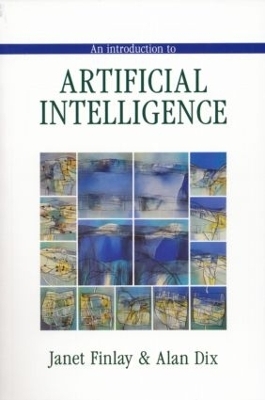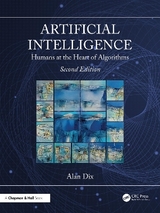
An Introduction To Artificial Intelligence
Routledge (Verlag)
978-1-85728-399-0 (ISBN)
- Titel erscheint in neuer Auflage
- Artikel merken
An authoritative and accessible one-stop resource, An Introduction to Artificial Intelligence presents the first full examination of AI. Designed to provide an understanding of the foundations of artificial intelligence, it examines the central computational techniques employed by AI, including knowledge representation, search, reasoning, and learning, as well as the principal application domains of expert systems, natural language, vision, robotics, software agents and cognitive modeling. Many of the major philosophical and ethical issues of AI are also introduced.
Throughout the volume, the authors provide detailed, well-illustrated treatments of each topic with abundant examples and exercises. The authors bring this exciting field to life by presenting a substantial and robust introduction to artificial intelligence in a clear and concise coursebook form. This book stands as a core text for all computer scientists approaching AI for the first time.
Janet Finlay
Preface -- Introduction -- What is artificial intelligence? History of artificial intelligence The future for AI -- 1 Knowledge in AI -- 1.1 Overview -- 1.2 Introduction -- 1.3 Representing knowledge -- 1.4 Metrics for assessing knowledge representation schemes -- 1.5 Logic representations -- 1.6 Procedural representation -- 1.7 Network representations -- 1.8 Structured representations -- 1.9 General knowledge -- 1.10 The frame problem -- 1.11 Knowledge elicitation -- 1.12 Summary -- 1.13 Exercises -- 1.14 Recommended further reading -- 2 Reasoning -- 2.1 Overview -- 2.2 What is reasoning? -- 2.3 Forward and backward reasoning -- 2.4 Reasoning with uncertainty -- 2.5 Summary -- 2.6 Exercises -- 2.7 Recommended further reading -- 3 Search -- 3.1 Introduction -- 3.2 Exhaustive search and simple pruning -- 3.3 Heuristic search -- 3.4 Knowledge-rich search -- 3.5 Summary -- 3.6 Exercises -- 3.7 Recommended further reading -- 4 Machine learning -- 4.1 Overview -- 4.2 Why do we want machine learning? -- 4.3 How machines learn -- 4.4 Deductive learning -- 4.5 Inductive learning -- 4.6 Explanation-based learning -- 4.7 Example: Query-by-Browsing -- 4.8 Summary -- 4.9 Recommended further reading -- 5 Game playing -- 5.1 Overview -- 5.2 Introduction -- 5.3 Characteristics of game playing -- 5.4 Standard games -- 5.5 Non-zero-sum games and simultaneous play -- 5.6 The adversary is life! -- 5.7 Probability -- 5.8 Summary -- 5.9 Exercises -- 5.10 Recommended further reading -- 6 Expert systems -- 6.1 Overview -- 6.2 What are expert systems? -- 6.3 Uses of expert systems -- 6.4 Architecture of an expert system -- 6.5 Examples of four expert systems -- 6.6 Building an expert system -- 6.7 Limitations of expert systems -- 6.8 Hybrid expert systems -- 6.9 Summary -- 6.10 Exercises -- 6.11 Recommended further reading -- 7 Natural language understanding -- 7.1 Overview -- 7.2 What is natural language understanding? -- 7.3 Why do we need natural language understanding? -- 7.4 Why is natural language understanding difficult? -- 7.5 An early attempt at natural language understanding: SHRDLU -- 7.6 How does natural language understanding work? -- 7.7 Syntactic analysis -- 7.8 Semantic analysis -- 7.9 Pragmatic analysis -- 7.10 Summary -- 7.11 Exercises -- 7.12 Recommended further reading -- 7.13 Solution to SHRDLU problem -- 8 Computer vision -- 8.1 Overview -- 8.2 Introduction -- 8.3 Digitization and signal processing -- 8.4 Edge detection -- 8.5 Region detection -- 8.6 Reconstructing objects -- 8.7 Identifying objects -- 8.8 Multiple images -- 8.9 Summary -- 8.10 Exercises -- 8.11 Recommended further reading -- 9 Planning and robotics -- 9.1 Overview -- 9.2 Introduction -- 9.3 Global planning -- 9.4 Local planning -- 9.5 Limbs, legs and eyes -- 9.6 Practical robotics -- 9.7 Summary -- 9.8 Exercises -- 9.9 Recommended further reading -- 10 Agents -- 10.1 Overview -- 10.2 Software agents -- 10.3 Co-operating agents and distributed AI -- 10.4 Summary -- 10.5 Exercises -- 10.6 Recommended further reading -- 11 Models of the mind -- 11.1 Overview -- 11.2 Introduction -- 11.3 What is the human mind? -- 11.4 Production system models -- 11.5 Connectionist models of cognition -- 11.6 Summary -- 11.7 Exercises -- 11.8 Recommended further reading -- 11.9 Notes -- 12 Epilogue: philosophical and sociological issues -- 12.1 Overview -- 12.2 Intelligent machines or engineering tools? -- 12.3 What is intelligence? -- 12.4 Computational argument vs. Searle's Chinese Room -- 12.5 Who is responsible? -- 12.6 Morals and emotions -- 12.7 Social implications -- 12.8 Summary -- 12.9 Recommended further reading -- Bibliography -- Index.
| Erscheint lt. Verlag | 27.6.1996 |
|---|---|
| Verlagsort | London |
| Sprache | englisch |
| Maße | 156 x 234 mm |
| Gewicht | 380 g |
| Themenwelt | Informatik ► Theorie / Studium ► Künstliche Intelligenz / Robotik |
| ISBN-10 | 1-85728-399-6 / 1857283996 |
| ISBN-13 | 978-1-85728-399-0 / 9781857283990 |
| Zustand | Neuware |
| Haben Sie eine Frage zum Produkt? |
aus dem Bereich



